The Newtown Historical Society toured Maspeth, Queens on July 31, 2011, a day featuring uncommonly good weather for any tour led by Your Webmaster. The Newtown Historical Society was founded to educate the public about the history of the villages that comprised Newtown Township in Queens County, NY. Newtown Township stretched from the East River to the Flushing River. Towns covered include: Maspeth, Elmhurst, East Elmhurst, Middle Village, Glendale, Ridgewood, Forest Hills, Rego Park, Woodside, Jackson Heights and Corona.
Maspeth, in a western corner of Queens east of Greenpoint and Williamsburg and west of Middle Village, seems stuck between the grit of Brooklyn and the airy, almost suburban atmosphere enveloping its eastern and southern neighbors. Maspeth was first settled by Native Americans centuries Dutch and English colonists arrived in the mid-1600s. It became a part of the borough of Queens, and then became a part of New York City in 1898. “Maspeth” is derived from Delaware Indian terms that have, by different accounts, meant “great brook” or “place of rising tides” due to its western end being situated next to Newtown Creek.
Federalist and Cowbird Triangles, Hamilton Place and Jay Avenue
This triangle’s name was inspired by the adjacent Hamilton Place, named for the American Revolution era patriot Alexander Hamilton (1755-1804), and the Federalist movement of which he was a participant. In 1787, Hamilton attended the Constitutional Convention in Philadelphia. An ardent believer in Federalism, Hamilton argued vigorously for the Constitution’s ratification in a series of articles co-authored with James Madison (1751-1836) and John Jay (1745-1829), known today as the Federalist Papers.
The Federalists, formed as a reaction against the ineffectual Articles of Confederation, offered a new and powerful vision of the American political system. The party supported a strong centralized government with a powerful system of checks and balances to prevent corruption or inequality, public credit and the promotion of commerce. The leaders of the Federalist Party feared that a representative government could be dangerous and lead to corruption if elected officials betrayed the trust of their constituents. The Federalist Party also established national banking and judicial systems. It placed emphasis on freedoms in commerce, banking, and manufacturing. Additionally, the policies of the Federalist politicians have had long-lasting effects on American foreign affairs. It organized the national government under the Constitution of 1787.
Playfully named by former Parks Commissioner Henry Stern in 1997 after Borden Avenue (the Borden Milk Company’s mascot is Elsie the Cow) and the jaybird. This park was once named Alexander Triangle, after nearby Hamilton Place, which was named after Alexander Hamilton (1755-1804). In recent years it was renamed the Technical Sergeant Thomas J. Davey Triangle after a local resident who died in battle during the Vietnam War.
Ridgewood Plateau signs, 65 Place and Hamilton Place
The area was known as the Ridgewood Plateau. The archways signaled entry into the Tudor-style development. The brick gateposts also indicate 65th Place’s former name, Hyatt Avenue. This was formerly the site of what was known in the 19th century as the “Maurice Woods”, and had been donated to St. Saviour’s Church by its founder, James Maurice. The intention of Maurice was that a seminary be built on the property, but the church found it needed money in order to survive and in the early 20th century it got permission from his surviving sisters to sell the land as development parcels. The Newtown Historical Society is working with Maspeth Federal Savings to restore the Ridgewood Plateau archways.
Polish-American National Hall, Clinton Avenue and 64th Street
As early as 1890, Polish immigrants chose Maspeth in which to settle. In 1921, the Polish National Home (or in Polish, “Polski Dom Narodowy”) was founded in order to teach younger generations about their Polish heritage. This building was erected in 1934. Members of this organization opened the 1939 World’s Fair, dedicated Maurice Park and participated in the opening of the Kosciuszko Bridge. Christina’s maternal grandparents and great-grandparents were very active in the organization. Maspeth has welcomed a new wave of Polish immigrants over the last decade. Storefronts along Grand and Maspeth Avenues reveal that the Polish tongue is the most popular foreign language in town, and their food may be the most popular cuisine.
Transfiguration Church, Perry Avenue east of 64th Street
One of the most gorgeous buildings in Queens. The first church was built in 1909 to serve the swelling population of Lithuanian immigrants. The present structure dates from 1962. Lithuanian folk art elements adorn the inside of the church. The Lithuanian phrase above the doors, Mano Namai Maldos Namai means “My house is a house of prayer.” Multiple Masses are still celebrated in the Lithuanian language each weekend. A replica of a Lithuanian roadside shrine sits in the churchyard of Transfiguration R.C. Church.
The first Transfiguration church was built in 1909 on Hull Avenue to serve the swelling population of Lithuanian immigrants. After that church burned down twice, the congregation moved to its present location on Perry Avenue, into what was St. Stan’s original building. St. Stan’s then built a new church on the site of Maspeth’s defunct Quaker Meeting house and cemetery.
Kowalinski Post, Maspeth Avenue near Grand Avenue:

Frank Kowalinski Post on Maspeth Avenue is where the Polish War Veterans gather and conduct business. But this structure was once one of Maspeth’s first firehouses. Belonging to a Volunteer Fire Company was a great distinction, whether a man belonged to an Engine Company or a Ladder Company. Only the prominent men of the village were asked to join and only the most respected of these men could hope to become Foreman.
Engine Company No. 4 was housed first in a frame building on Grand Avenue which stood at the present location of Laurel Venetian Blinds, near 64th Street.
About 1895, No. 4 moved here. Ladder Company No.5 was located in a frame building on Perry Avenue which is currently crossed by the Long Island Expressway. When a fire occurred in Maspeth, the Fire siren on top of the Alden Sampson Oil Cloth Factory would scream out its summons and fire fighters would race to the Firehouses to receive their direction. When a sufficient number of men had reported to the fire house, the fire company proceeded to the fire.
Engine Companies 4&5 were abandoned when the modern firehouse of Maspeth was built by the City in 1915 at 68th Street and Borden Avenue.
Queens County Hotel, Remsen Place and Grand Avenue
The Queens County Hotel, built in 1851 on today’s Grand Avenue and Remsen Place, served farmers from Long Island who were hauling wagon loads of produce to Brooklyn’s Wallabout Market. The hotel was one of many that sprang up on Grand Avenue. The wheelwright (see next entry) also served the farm workers. It was a long trip by wagon, and the weary wagon drivers and passengers would stay the night and take a meal, and not a few drinks.
‘
Mount Olivet Cemetery, Remsen Place and Grand Avenue
This garden cemetery was founded as an Episcopal Cemetery in 1850 and opened to all faiths the following year. One of the founders, James Maurice, was a U.S. Congressman, Maspeth landholder and founder of St. Saviour’s Church. He is buried here along with his 2 brothers and 3 sisters, none of which ever married. Prince Matchabelli and Helena Rubenstein of cosmetic fame are also buried here, as is gangster Jack “Legs” Diamond.
Necrology: Griff’s Hardware Site, Grand Avenue and Hamilton Place
This location was once Wielback’s Grocery, one of the town’s first supermarkets, before it became Griff’s Hardware more than 90 years ago. They recycled their classic neon sign when they converted the store into a laundering business in 2000. The laundromat closed in 2007 and the property was in the process of demolition to make way for a financial institution.
Necrology: Wheelwright Site, Grand Avenue and Hamilton Place
Anton Fausner’s wheelwright and wagonmaker’s shop from when horses and carriages were the main method of transportation once occupies the Polish-Slavic Union. The wheelwright’s ground floor later housed Maspeth Auto Parts, and several very old signs from that incarnation remained (“Brakes, clutches, pinfitting”) until the building was razed.
Haflinger House, Brown Place and 58th Avenue
Gustav Haflinger, Maspeth’s town butcher, built this house in the 1880s. Subsequent owners of his house have taken great care to keep it in good condition, down to the paint detailing on the railings. Several houses along Brown Place and 58th Avenue exhibit one-of-a-kind wooden craftsmanship.
Frontera Park/trolley barn site
The Maspeth Trolley Barn was located at Grand Avenue and Brown Place. Part of it sat in the path of the Long Island Expressway. Frontera Park was eventually built on the rest of its footprint. Trolleys ran in Queens until 1949 when they were replaced by buses. The trolley barn was used as a bus depot until the LIE was cut through Maspeth in the 1950s.
9/11 War Memorials and Manhattan View, Grand Avenue at 69th Street
This intersection is considered to be the center of town; therefore, it is a fitting site for Maspeth Memorial Square. The square contains war memorials, the town Christmas tree, a huge American flag and a memorial to 9/11 victims from Maspeth. Engine Company 288/Haz Mat 1, located just north of the square, lost 19 men on 9/11/01, the most of any firehouse in the city. The town gathered to watch the horror unfold from this site on that horrible day. The site offers a commanding view of almost the entire Manhattan skyline.
Maspeth Theatre, Grand Avenue/69th Lane
Before the days of multiplexes there was one movie per theatre, and you also got comedians, dancing girls and maybe a trained chimp or two. The Maspeth, on Grand Avenue and 69th Place, now a pharmacy, was the largest of the town’s three theatres. The theatre was built in 1924 with 1,161 seats by Straus and Strausberg. The theater was taken over by William Fox in 1927 but went into bankruptcy in the crash of 1929. The successor company, Metropolitan Playhouse, assigned it to a company called Randforce Amusement Company. Randforce Amusement ran the theater until 1965 when it closed its doors forever. Today the building hosts a number of ever-shifting businesses.
Garlinge Triangle, 57Th Avenue and Grand Avenue
Maspeth’s WWI Memorial, named for a local soldier, Walter Garlinge. Erroneously spelled, and despite the Parks Department signage, Garlinge was not the first Maspeth resident to lose his life in the war (he was likely the last). It was designed by architect Paul C. Hunder and constructed in 1931.
57th Avenue, formerly the Hempstead Plank Road, was a main route to Flushing and Hempstead beyond in the 1800s.
Maspeth Town Hall, 72nd Street north of Grand
The “Maspeth Town Hall” on 72nd Street north of Grand Avenue was never the actual town hall (of Newtown), though it did serve in a municipal capacity before becoming a public school and later a police stationhouse. It went up in 1897, not 1802, as the sign says.
Elmhurst Park, 79th and Grand
The site of Elmhurst Park was once the location of two KeySpan Newtown gas holders, a highway landmark popularly known as the “Elmhurst gas tanks.” With the support of the community, the site was sold by KeySpan to the City of New York for $1 and was cleaned up and returned to the public as open space.
The park now features lush lawns, jogging paths, seating, sculpture, modern comfort stations, safety lighting, and more than 620 trees. The playground, designed for tots and young children, is energy-themed, in keeping with the site’s history. At the playground, can pedal a stationary bike to provide a light effect on a nearby column. The new park is also in keeping with sustainable practices. Storm water at the site will be collected in an underground retention system to reduce the amount of water flowing into the sewer pipes in the street.
Mathews Model Flats, 80th Street and Grand
The streets of Long Island City, Ridgewood and to a lesser degree, Woodside, are lined with blond bricked Matthews Model Flats, each unit produced for $8000 in 1915 by Gustave X. Mathews, who is virtually unknown today but responsible for much classic residential architecture in Queens. The distinctive yellow bricks were produced in the kilns of Balthazar Kreischer’s brick works in the far reaches of Staten Island. (The Kriescher and Long Island City stalwarts, the Steinways, were linked by marriage.) These were the final Mathews Flats built in NYC and were executed by architect Louis Allmendinger.
St. Adalbert Church, 83rd Street
Saint Adalbert (956 –997), a Bishop of Prague and a missionary, was martyred in his efforts to convert the Baltic Prussians. He was later made the patron saint of Bohemia, Poland, Hungary and Prussia.
St. Adalbert’s was founded as a parish in November 1892 by a small group of Polish immigrants to respond to the needs of the Polish-speaking people of Elmhurst, Maspeth, and the surrounding areas. The church, at the peak of one of Elmhurst’s higher hills, can be seen from Woodside. The present-day church structure was erected in 1947.
Elks Hall, Simonson Street-Queens Boulevard
This handsome brick building on Queens Boulevard near 51st Avenue was once the largest Elks Lodge on the East Coast, with 60 rooms, bowling alleys, billiards, a ladies’ lounge, and a 50 foot bar. The Elks don’t own the old place any more: it’s been sold to the New Life Fellowship, a Korean church organization. The Ballinger Company designed the granite, limestone and brick structure dominated by a now-verdigris-covered elk at the front entrance. For a couple of decades, Extreme Championship Wrestling (ECW) bouts have been held here featuring some of the legends of “sports entertainment” such as the Sandman and Mick Foley. The Elks Lodge is an official New York City Landmark.
Check the Newtown Historical Society page for future events and tours!
Photos by NHS Secretary Treasurer Steve Garza
9/4/11















9 comments
Wonderful items from you, man. I’ve keep in mind your stuff prior to and you’re just extremely magnificent. I actually like what you have bought here, really like what you’re stating and the best way by which you are saying it. You’re making it entertaining and you continue to care for to stay it wise. I can’t wait to learn much more from you. This is actually a terrific site.
Hello,I used to live at 73-43 grand ave maspeth,It was a 3 story gray building next to a junk yard and across the way from the bowling alley..it is now torn down,I would like to no if you have any info on that house,i was born 1968 and lived there till i was 10,i remember things that i would like to no about that house like who owned it and when was the 6 apartmrnts put in..the front yard was huge and i remember the landlords name was dominick and he had every fruit and veg growing..i just want to no any info please.. thank you so much the house had to be old.. thank you dawn
My grandfather ( William Monteverde) was a supreme court judge and lived at 72-15 Grand Ave also in a huge 3 story building. I have a record stating he also died there on Jan. 25, 1934. My husband took me there and at the time it was a legion of some kind in the bottom portion and a lawyer and doctors offices on the second floor but all had entrances from the outside of the building. I also would like any information on the building. Thank you for your time!
Joanne
Monteverde lived in the Brinckerhoff house which was demolished for the structure there now.
My folks had their wedding reception @ the Queens Blvd. Elks club, my Pop still has the receipt for $54.00 dated 1941.
Across Queens Blvd from the old Elk’s Lodge is where the fake fast-food restaurant “McDowell’s” stood for the Eddie Murphy film, “Coming to America”.
In the movie, in at least one scene you can see the old Elk’s Lodge. In other scenes, you can see the Jamaica Savings Bank, and even a glimpse of the tower of Newtown High School.
i found a old milk bottle thats says albert bros on jay ave maspeth li can you tell me some thing about it ? thank you
We are wondering what the name of a grocery store on 83 street and grand ave ,it’s now a parking lot
Is this the George Uss that went to St. A’s back in the 50’s orc so?
Did you have a brother by the name of Frank?
This is Justin Dauibar-class of 1955 of St. A’s.
Please contact me at juddaubar@hotmail.com